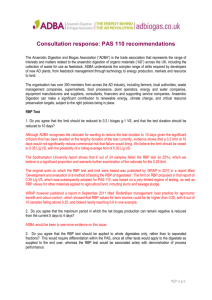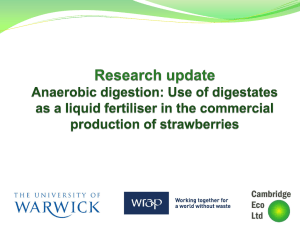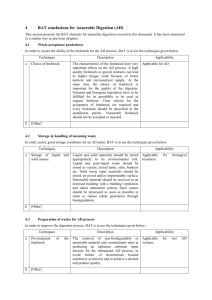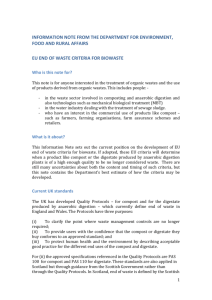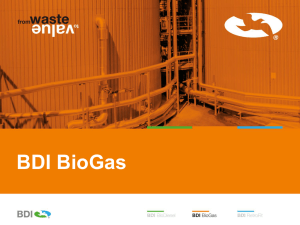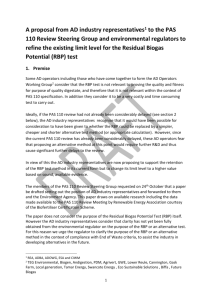Consultation_questions_resent_190313
advertisement
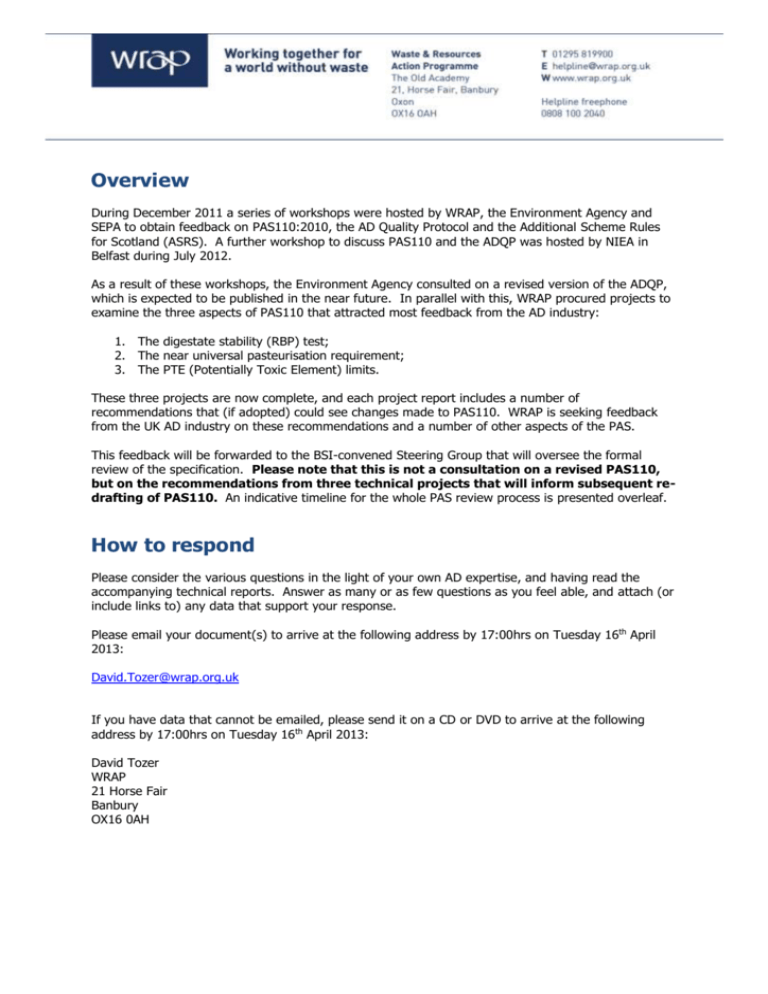
Overview During December 2011 a series of workshops were hosted by WRAP, the Environment Agency and SEPA to obtain feedback on PAS110:2010, the AD Quality Protocol and the Additional Scheme Rules for Scotland (ASRS). A further workshop to discuss PAS110 and the ADQP was hosted by NIEA in Belfast during July 2012. As a result of these workshops, the Environment Agency consulted on a revised version of the ADQP, which is expected to be published in the near future. In parallel with this, WRAP procured projects to examine the three aspects of PAS110 that attracted most feedback from the AD industry: 1. The digestate stability (RBP) test; 2. The near universal pasteurisation requirement; 3. The PTE (Potentially Toxic Element) limits. These three projects are now complete, and each project report includes a number of recommendations that (if adopted) could see changes made to PAS110. WRAP is seeking feedback from the UK AD industry on these recommendations and a number of other aspects of the PAS. This feedback will be forwarded to the BSI-convened Steering Group that will oversee the formal review of the specification. Please note that this is not a consultation on a revised PAS110, but on the recommendations from three technical projects that will inform subsequent redrafting of PAS110. An indicative timeline for the whole PAS review process is presented overleaf. How to respond Please consider the various questions in the light of your own AD expertise, and having read the accompanying technical reports. Answer as many or as few questions as you feel able, and attach (or include links to) any data that support your response. Please email your document(s) to arrive at the following address by 17:00hrs on Tuesday 16th April 2013: David.Tozer@wrap.org.uk If you have data that cannot be emailed, please send it on a CD or DVD to arrive at the following address by 17:00hrs on Tuesday 16th April 2013: David Tozer WRAP 21 Horse Fair Banbury OX16 0AH How this consultation fits with the approaching PAS110 review Page 2 of 12 Residual Biogas Potential (RBP) Background The Residual Biogas Potential (RBP) test is a compulsory component of PAS110, providing a measure of genuine gas potential and thus of how effectively an AD plant has digested the feedstock. This is the measure that shows that the input ‘waste’ materials have been recovered. The current RBP test limit was set by comparison of the stability demonstrated by digestate samples available at the time PAS110 was developed, with a small number of livestock slurries that were considered acceptable for spreading (untreated) to agricultural land. The stability of digested sewage sludge was also considered, but this was found to be much more stable than either livestock slurries or digestates, and a compromise figure of 0.25 l/g of volatile solids (VS) was suggested and agreed with the industry prior to publication of the PAS in 2010. Feedback (via the Biofertiliser Certification Scheme (BCS)) has indicated that some AD facilities are experiencing difficulty with achieving the required digestate stability. It seems that this particularly relates to plants accepting high proportions of food waste. At the same time, other plants accepting similar inputs are (apparently) achieving the required stability with ease. There has also been some confusion around the purpose of the test. As stated above, it was developed to demonstrate that digestion had taken place – but it is possible that the test (and its limit) could also offer a control over the environmental impacts arising from the use of digestates. This project examined various aspects of the RBP test, including: Reproducibility; Robustness; Limit; Duration; Potential to deliver ‘process’ and ‘use’ outcomes; Correlation with VFAs (Volatile Fatty Acids); Suitability as a test for aerobic digestates; Availability of suitable alternatives. It also considered the JRC’s proposed ‘End of Waste for Biowaste’ stability test1. Conclusions, recommendations and questions. Please note that the bullet points below have been transposed from the accompanying report – they should not be interpreted as representing any view other than that of the report’s authors. It is likely that the test duration could be reduced to 10 days, with a corresponding reduction in the limit value to 0.2 l biogas g-1 VS. Question 1. Do you agree that the limit should be reduced to 0.2 l biogas g-1 VS, and that the test duration should be reduced to 10 days? It is recommended that the maximum period in which the net biogas production can remain negative is reduced from the current 5 days to 4. Question 2. Do you agree that the maximum period in which the net biogas production can remain negative is reduced from the current 5 days to 4 days? 1 http://susproc.jrc.ec.europa.eu/activities/waste/documents/IPTS_EoW_Biodegradable_waste_3rd_working_document_wo_line_ nr.pdf Page 3 of 12 The RBP test should be applied to whole digestates only, rather than to separated fractions. Question 3. Do you agree that the RBP test should be applied to whole digestates only, rather than to separated fractions? This would require differentiation within the PAS, since all other tests would apply to the digestate as supplied to the end user, whereas the RBP test would be associated solely with demonstration of process performance. The sampling point should be specified as the outlet of the final tank from which biogas is collected for processing rather than simply vented. Question 4a. Do you agree that the sampling point should be specified as the outlet of the final tank from which biogas is collected for processing rather than simply vented? Question 4b. If yes, do you think that this definition is sufficiently clear for inclusion with PAS110, or are you able to suggest a clearer alternative? The interval between testing may need to be reviewed. Question 5. The current (post-validation) testing frequency is 2 per 12 months and not within 3 months of each other, or sooner if and when significant change occurs . Do you think that this should be changed? If so, please state how and provide data to support your suggestion(s). High VFA concentrations are known to occur in animal slurries and some aerobic composts that are commonly applied to land, and it is therefore considered inappropriate to consider setting an ‘environmental outcome’ VFA limit for digestates only. Question 6. At present, PAS110 includes limits for PTEs, physical contaminants and bacterial indicators. Do you consider that PAS110 should include further ‘environmental outcome’ tests? If so, please state what these should be and provide data to support your suggestion(s). There are no grounds for using VFA concentration as a product stability criterion. Question 7. Do you agree with this assertion? If not, please state why and provide data to support your case. Page 4 of 12 The small number of comparative studies carried out has indicated good correlation between biogas potential tests and respirometric tests on digestates. Question 8. WRAP are currently procuring a project to examine this question further. Please provide data comparing RBP and aerobic respirometric tests (or links to such data). The current RBP test protocol does not contain any instructions on the treatment of outlier results due to [lab] equipment failures (e.g. leakage) and it is suggested that a minor amendment is added to deal with this point. Question 9. Do you agree that such an amendment is appropriate? If so, please provide a form of words that you would consider suitable for inclusion within the current method2. The RBP test does not appear to be a logical choice for assessing the performance of an aerobic digester, as the primary metabolic routes to stabilisation are aerobic in such systems. Question 10. Do you agree with assertion? If not, please state why and provide data to support your case. Question 11. Do you have any other comments on this aspect of PAS110? 2 http://www.wrap.org.uk/sites/files/wrap/Residual%20Biogas%20Potential.pdf Page 5 of 12 Pasteurisation Background Where AD processes accept suitable low-risk animal by-products (ABP), they must comply with the ABP Regulations, which include: Testing digestates for bacterial indicators; Restricting access to feedstocks and digestate by farm livestock; A compulsory pasteurisation step either before or after the anaerobic digestion phase3. PAS110 extends this pasteurisation requirement to all feedstocks, including silage grass and maize. The only exception to this is when feedstocks arise, are digested on and the digestate returned to the same holding. Various pasteurisation options are listed in the PAS, but as these were not specifically developed to manage potential phytohygiene hazards associated with anaerobic digestion. Since non-PAS110 AD systems that only accept manure and purpose-grown crops (including silage) need not include a pasteurisation stage4, there have been calls from within the AD community to exempt silage crops from the current PAS110 pasteurisation requirement. There have also been calls to exempt other specific inputs, particularly those that derive from processes including significant thermal treatment (such as distillery residues). Set within this context, it must also be considered that pasteurisation is seen as highly desirable by digestate users and specifiers (such as farm assurance schemes) because it provides a clear microbiological hazard control point that is less simple to define and audit through other means (for example, by relying on the hazard-reducing potential of mesophilic anaerobic digestion alone). This project examined various aspects of the pasteurisation requirements, with a specific focus on non-ABP inputs. These aspects included: Potential to exclude specific feedstocks; ‘Standard alternatives’ to the current range of pasteurisation options; Potential for ‘Bespoke alternatives’ to be considered and validated. Conclusions, recommendations and questions. Please note that the bullet points below have been transposed from the accompanying report – they should not be interpreted as representing any view other than that of the report’s authors. The evidence gathered during this project suggests that a combination of pasteurisation and anaerobic digestion is required for elimination of some plant pathogens. Since it is possible that continuous or semi-continuous AD systems will allow pathogens to bypass the reductive effects of digestion our data support the retention of a discrete pasteurisation step in the PAS110 specification, although recognise the importance to industry of flexibility in pasteurisation approach. Question 12a. Whilst many AD feedstocks are considered low-risk from a phytohygiene perspective, some cannot be considered ‘no risk’ in AD systems that do not include a pasteurisation stage. The authors of this report suggest that feedstocks could be risk-assessed to determine whether they should be exempted from the pasteurisation requirement. For the purposes of auditability, a risk assessment option within PAS110 may not be appropriate. What are your views on this? 3 There are exceptions to this, particularly at the very small scale. For example: http://animalhealth.defra.gov.uk/managing- disease/animalbyproducts/compost-biogas-manure/home-small-site-composters-ad-plants.htm 4 http://www.environmentagency.gov.uk/static/documents/Research/PS_029_AD_of_agricultural_manures_and_slurry_final.pdf Page 6 of 12 Question 12b. Do you think that specific feedstocks should be exempted from the pasteurisation requirement? If so, please state what they are and provide data to support your assertion that they should be exempted. Please also suggest suitable forms of words that could encompass your proposed exemptions in a revised PAS110. Please bear in mind that the auditability of the PAS cannot be compromised. This means that it might not be appropriate to co-opt operations into the PAS that are outside the scope of the current auditing process (such as field application records). Whilst other authors have proposed a number of pre-defined pasteurisation parameters, these are not proven for the wide range of potential crop pests and diseases that could be associated with some feedstocks (albeit at low levels), and they also require adherence to minimum hydraulic retention times within the digestion phase – which would reduce the flexibility of PAS110. Question 13. Do you agree with the assertion that other pre-defined approaches to pasteurisation may not be appropriate for PAS110, given their reliance on minimum hydraulic retention times within the digestion phase? If not, please state why and provide data to support your case. The concept of Pasteurisation Units (PU) sets out to quantify the amount of pasteurisation that has taken place by expressing the process in terms of time, temperature and a Z-value which varies depending on the heat stability of the organism(s) in question. Since a time-temperature regime for pasteurisation currently exists in the PAS110 specification, it is conceivable that the PU approach could be useful in determining acceptable alternative time/temperature combinations. However, the Z value is dependent on the persistence of the microbial hazard (and conceivably on the chemical environment during pasteurisation) so some validation would be required to ensure that an alternative regime proposed was equivalent to the PAS110 pasteurisation treatment as currently defined. Question 14. If the current PAS110 pasteurisation regime were to remain in place, the concept of Pasteurisation Units to design bespoke approaches for control of phytohygienic hazards is extremely appealing, since it would rely on a simple set of calculations to define suitable time/temperature regimes. However, data to support this approach appear scarce. If you are able, please attach data demonstrating the use of Pasteurisation Units to design systems intended to mitigate phytohygienic hazards in AD systems. General comments on the PU approach can be added below: Page 7 of 12 Instead, we propose a validation process by which operators can demonstrate that their process, operated by their personnel, is sufficiently effective at reducing plant pathogen risk. For such validation we propose that any suggested alternative to the standard 70°C for one hour pasteurisation approach be tested for its ability to achieve a defined level of kill of indicator organisms introduced into the pasteurisation system. To aid analysis we propose that these organisms are introduced in sealed containers for ease of recovery and subsequent analysis, and because inoculating an entire reactor with a detectable level of indicator organism would not be practicable. Having considered various options, including those required by the German Biowaste Ordinance, we suggest that relatively persistent organisms for which viability assays can be conducted are chosen as indicators, and for this reason propose Plasmodiophora brassicae and tomato seed. Question 15. If the current PAS110 pasteurisation regime were to remain in place, the concept of a standardised approach for validating alternatives is extremely appealing. Do you support the proposal to use Plasmodiophora brassicae and tomato seeds as indicator species for such validation? If not, please state why and provide data to support your case. Question 16. Do you have any other comments on this aspect of PAS110? Page 8 of 12 Potentially Toxic Elements (PTEs) Background When PAS110 was originally compiled, there was an extremely small commercial Anaerobic Digestion (AD) sector in the UK, and data for digestate quality were scarce. Limits for Potentially Toxic Elements (PTE) were therefore drawn across from the compost specification (PAS100), which are set on a dry matter (DM) basis. It was always thought possible that AD operators would find it difficult to consistently adhere to these limits, as there are very low DM contents in whole and liquor digestates. To overcome this difficulty, an alternative control mechanism was written into PAS110 in the form of annual limits on PTE application rates to soil (per hectare). These are listed in the 1989 Sludge Use in Agriculture Regulations5, which require operators to monitor PTE loading rates to comply with a 10 year rolling average. This presents an auditing challenge, since it (technically) requires that digestate be traced from production through to use over at least this time period. A number of alternatives to the current approach have been suggested by UK AD operators that could be suitably protective of the environment. These include: PTE limits set on a mg/l (fresh) basis; PTE limits set as ratios with specified nutrients (which latter tend to restrict application rates). This project examined these options. It also considered the JRC’s proposed ‘End of Waste for Biowaste’ PTE limits, and discusses their potential impact on the UK AD industry. Conclusions, recommendations and questions. Please note that the bullet points below have been transposed from the accompanying report – they should not be interpreted as representing any view other than that of the report’s authors. Establishing unduly low limits that do not provide proportionate environmental or health benefits places unnecessary constraints on the resource management industry and restricts opportunities for closing nutrient cycles through land application. In the context of soil protection where organic materials are applied to agricultural land, the starting soil PTE concentration and the quantity of PTEs applied to soil are the most important criteria. Notably, typical digestate PTE loading rates to soils are lower than or similar to those from other organic materials that are commonly applied to agricultural land. Analysis of the database of 90 food-based digestate samples showed that mean PTE concentrations in food-based digestates were below the current BSI PAS110 and proposed EoW limit values. However, the data indicated that around 13% of the samples would not meet the current BSI PAS110 limit for Zn, 8% for Cd, 3% for Ni and 7% for Cu (and 17% the lower EoW limit for Cu). Notably, mean concentrations of PTEs in biosolids and livestock manures that are widely applied to agricultural land are commonly higher than the current BSI PAS110 and proposed EoW limits for digestate and compost. The majority of digestates are produced and managed as liquids, and hence are analysed in the laboratory on a sample ‘as received’ basis. This study concluded that it would be more appropriate for PTE limit concentrations in digestates to be set on a fresh weight basis, rather than on a dry matter basis as is currently the case; this would be consistent with the reporting of nutrient analyses, minimise PTE analytical detection limit problems and reduce the chances of laboratory errors occurring during fresh to dry matter concentration conversions. 5 http://www.legislation.gov.uk/uksi/1989/1263/contents/made Page 9 of 12 Question 17. Do you agree with the conclusion that it would be more appropriate for PTE limit concentrations in digestates to be set on a fresh weight basis? If not, please state why and provide data to support your case. Embracing the precautionary principle to ensure that digestate applications are as protective of the soil environment as is reasonably achievable and within the ethos of prevention of pollution, we recommend that (fresh weight) PTE limit concentrations are based on PTE addition rates to soils (in context with other commonly applied organic materials), and that PTE loading rates should not exceed those from compost which are considered in EU guidance to be protective of the soil. The following PTE concentration limits are proposed to protect the receiving soil environment. Question 18a. Do you agree that it is appropriate to have separate limits for liquid and fibre digestates? If not, please provide data to support your case. Question 18b. Do you agree that the distinction between liquid and fibre digestates should be set at 15% dry matter? If not, please provide data to support your case. Question 18c. Do you agree with the proposed PTE limit values? If not, please provide data to support your case. Question 19. Do you have any other comments on this aspect of PAS110? Page 10 of 12 Other aspects of PAS110 During 2012, a number of other aspects of PAS110 were drawn to the attention of WRAP. These have been listed below, and you are provided with an opportunity to comment. Feedback from an AD operator: As an operator producing digestate with a low total solids content, typically between 3-4% we are left with very little solid matter when put through a 2mm screen. The test method does not take into account the weight of the ‘received sample’ in the calculation and works only on the dry matter of the material. Due to the limited content of solid in the material any piece of plastic or cornstarch will make up a significant percentage of the total dry matter content and will therefore exceed the limit set out in PAS 110 even though these contaminants would represent a small percentage of the total ‘as received’ sample. As described above, the limit for physical contaminants is set on a dry matter basis. Taking a similar approach to that adopted when considering PTE limits, it would seem appropriate to consider setting physical contaminant limits on a fresh weight or ‘as received’ basis. PAS110 currently uses a bespoke method for determining the level of physical contaminants in digestate. This relies on digestate samples being dried, and physical contaminants determined in the dry residue. The draft European standard CEN/TS 16202 takes a similar approach. WRAP are not aware of any tests for determining physical contaminants in whole (‘as received’) digestate samples. Question 20a. Do you agree that levels of physical contaminants should be set for digestates on an ‘as received’ basis? If so, please state why and provide data to support your case. If not, please state why and provide data to support your case. Question 20b. Do you agree that different limits should be set for physical contaminants in whole/liquor and fibre digestates? If so, please suggest appropriate limits and provide data to support your case. If not, please state why and provide data to support your case. Question 20c. Are you aware of methods for determining physical contaminants in whole (‘as received’) digestate samples? If so, please provide copies of appropriate documentation – or links to the same. Digestate can be odorous – with such odours becoming particularly apparent during digestate spreading. This can be the case whether digestate meets the current PAS110 stability requirements (RBP test and limit) or not. Digestate spreading techniques are available that could minimise the risks of odour generation during spreading, and maximise the agronomic value of digestates6. However, the auditing of such techniques is outwith the scope of PAS110. In jurisdictions other than the UK, limits on odour have been imposed on materials that can be spread to land7 – although the potential costs of the associated testing are unknown. Question 21a. Do you think that PAS110 should include limits on digestate odour? If so, please suggest appropriate limits and provide data to support your case. If not, please state why and provide data to support your case. 6 7 http://www.wrapcymru.org.uk/sites/files/wrap/Digestate%20odour%20management%20-%20Cymru.pdf http://www.omafra.gov.on.ca/english/nm/regs/nmpro/odour08_09.htm Page 11 of 12 Question 21b. Do you have any other suggestions around whether/how digestate odour mitigation could be more directly addressed within PAS110? The Thermophilic Aerobic Digestion (TAD) industry in the UK is small, but does provide an alternative to treatment of food wastes via Anaerobic Digestion or composting. At present the separated fibre fraction of TAD outputs is eligible for inclusion within PAS100. However, the whole aerobic digestate and separated liquor fall outwith the scope of both PAS100 and PAS110. The lack of a specification and Quality Protocol for such aerobic digestates means that they have to be spread to land as wastes. Question 22. Should aerobic digestates (whole, separated liquor and separated fibre) be brought within the scope of PAS110? If so, please suggest appropriate tests and test limits, and provide data to support your case. If not, please state why and provide data to support your case. During 2012, a consultation was held on a proposed digestate standard in the Republic of Ireland. Many of the tests and associated limits within this proposed standard are different to those specified in PAS110 (indeed, many of the suggested standards are themselves only available as drafts). Question 23. Do you think that there are elements of the proposed Irish standard that should be considered during the review of PAS110? If so, please state why and provide data to support your case. The questions above are based on feedback provided to WRAP by the UK AD industry over the past year, and should not be considered comprehensive. Question 24. Are there any other comments that you would like to make on PAS110? Where these include suggestions to change limits to biological, physical or chemical tests – please provide data to support your case. Many thanks for taking time to respond to this consultation Page 12 of 12
